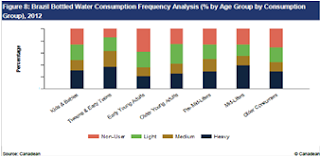This report offers:
- Consumer data based on proprietary surveys and consumer group tracking and modeling for the following specific categories: Bottled Water, Sparkling Soft Drinks, Concentrates, Functional Drinks, Smoothies, Juices, and Ready to Drink Tea & Coffee.
- Detailed consumer segmentation covering 26 consumer groups, 20 consumer trends, and consumption frequency for each product category.
- Consumer penetration for brands and private labels, based on the original survey results augmented with subsequent consumer tracking and modeling.
- Unique retailer choice data at the product category level, again based on the original survey results’ augmentation with consumer tracking and modeling.
Request a sample copy of this report @ http://www.rnrmarketresearch.com/contacts/request-sample?rname=126579
.
This will facilitate:
- A clear understanding of who is consuming what and what is motivating this consumption.
- Accurate quantification of the impact of consumer trends on specific segments of the market, as well as the market as a whole.
- The informed updating of marketing tactics and strategic planning based on the very latest consumer behavior.
Individualism and Personal space and time are identified as having Greatest Impact on Consumer Behavior in Brazil’s Soft Drinks market.
As economic and societal change drives incremental evolution of behavioral patterns, consumers’ consumption patterns can undergo changes as a result of a multitude of different trends: from indulgence to media influence, from aspirations for healthy lifestyles to the shifting state of gender roles, an understanding of which segments of society are consuming which products and why provides companies with an invaluable insight into the motivating forces of the market, allowing them to position their products with maximum efficiency and reap the greatest rewards.
Consumer specialist new report – The Brazilian Soft Drinks Market: What Consumers Drinks and Why? – is the result of its unique, highly detailed, and proprietary study of consumers’ Soft Drinks consumption habits, offering highly segmented data on the influence of 20 consumer trends on 26 consumer groups over 7 product categories within the Soft Drinks sector. Together with its provision of consumer penetration data for brands and private labels, and unique retailer choice data at the product category level – both of which augment original survey results with subsequent consumer tracking and modeling – this report answers the key questions integral to any Consumer Packaged Goods organization’s success: who is consuming what, and what is motivating this consumption? With its accurate quantification of the impact of consumer trends on specific segments of the market, The Brazilian Soft Drinks Market: What Consumers Drinks and Why? Facilitates informed updating of marketing tactics and strategic planning, and should be considered required reading for those serious about capitalizing on the opportunities in Brazil’s Soft Drinks market.
Some key insights include:
- Consumers’ uptake of products and the influence of consumer trends are fundamental causes of change in markets – making knowing what these trends are and the extent of their influence crucial. The survey-based data provided in this report examines over 20 consumer trends that affect the market and examines the share of consumption across 26 consumer groups. This data provides a detailed insight into exactly who the consumer is and just how much impact the latest consumer trends are having.
- Consumer segment analysis reveals that Brazil’s Better Off income group accounts for nearly one-third of the total soft drinks market in value terms. Rising wage levels and new job opportunities created by Brazil’s increasing integration with the global economy has increased both the size and spending power of middle income groups in the country.
- Consumption frequency analysis reveals that over half of Brazilian Early Young Adults don’t consume Concentrates, a strong reduction from the next youngest age group, Tweens & Early Teens, where only 25% of consumers are non-users. Consequently, marketing planners will need to design their campaigns for Soft Drink Concentrates to account for this decline in consumption.
- Consumption frequency analysis reveals that non-users of Ready to Drink Tea & Coffee account for between 60%-85% of consumers among the different age categories in Brazil. This low penetration means that suppliers need to carefully target those that do consume ready to Drink Tea & Coffee or take action to increase the number of consumers.
- Market value analysis reveals that Sparkling Soft Drinks, Juices, and Bottled Water together account for more than 80% of the total market by value in Brazil. Ready to Drink Tea & Coffee is the smallest soft drinks segment.
- Brand analysis reveals that private labels have more than25% penetration in the Smoothies market in Brazil compared to less than 2% penetration in Sparkling Soft Drinks, where private labels compete against strong international brands such as Coca-Cola and Pepsi.
- Consumer survey results suggest the fast pace of modern life and consumers’ wish to express individuality and personality are key determinants for the consumption of soft drinks in Brazil.
Complete report is available @ http://www.rnrmarketresearch.com/the-brazilian-soft-drinks-market-what-consumers-drink-and-why-market-report.html
.



No comments:
Post a Comment
Note: only a member of this blog may post a comment.